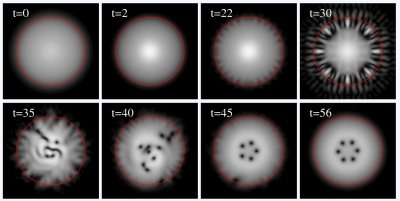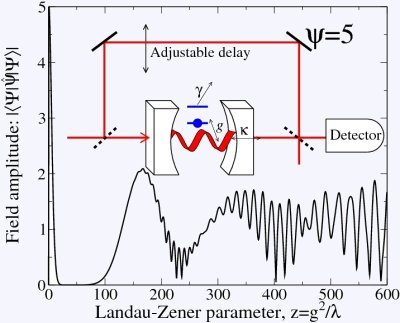Condensation of Excitons and Polaritons
Excitons and Polaritons
Excitons are excitations in semiconductors, consisting of a
bound electron and hole (missing electron); they may be created
by shining light on a semiconductor, exciting an electron to a
new excited state; both the electron and the hole
corresponding to the old state of the electron can move about
independently, but because of electric interactions, the
electron is attracted to the hole, and they may form a bound
state. In appropriately engineered systems, such as coupled
quantum wells — thin layers of differing semiconductor,
choosen to trap electrons or holes — excitons can be
made relatively stable and have a significant lifetime.
Microcavity polaritons are mixtures of photons (quantised
particles of light) and excitons ; this mixing is achieved
using mirrors to build a cavity that confines light, and
placing a quantum well that confines excitons between these
mirrors.
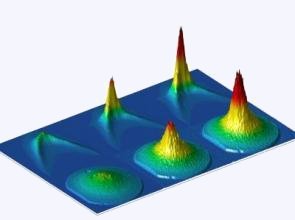
Occupation of different energy/momentum states across the
condensation threshold for microcavity polaritons: left-most
case is uncondensed, right-most is condensed. The further
set of images show occupation versus energy and momentum,
the nearer show occupation versus two components of
momentum.
[Adapted from Kasprzak et al,
Nature 443 409 (2006)]
Condensation
Condensation in this context refers to
a phase transition, generally at low temperatures, below which
the quantum system behaves coherently; roughly one may think of
this as all particles behaving identically; i.e. many particles
occupying the same quantum mechanical wavefunction. It is this
coherence, resulting from sharing the same wavefunction, that
means quantum mechanical effects may become visible on large scales
Examples of such condensates include superconductivity (where
there is flow of current without electrical resistance) and
superfluidity of liquid Helium (where there is fluid flow
without mechanical resistance). Superconductivity and
superfluid Helium are however somewhat exceptional as quantum
condensates: they are the true equilibrium states of the given
material. The last decade has seen an increasing range of
other quantum condensates in systems which are not in perfect
equilibrium. These include cold dilute gases of alkali atoms
and very recently condensates of quasi-particle excitations in
semiconductors, microcavity polaritons
Microcavity polaritons can form quantum condensates at much
higher temperatures than the cold atomic gases, but are
further from equilibrium due to the finite lifetime of the
polaritons. While the equilibrium condensate, and the highly
non-equilibrium laser have been extensively studied,
exploration of systems between these two limits have has only
begun recently.
Non-equilibrium
One particular area of interest is in understanding how the
properties of condensates consisting of particles with finite
lifetimes differ from these two extreme limits of the Laser
and the equilibrium condensate. My work to date has addressed
questions about: how correlation functions, studying the
coherence between polaritons in different places, are modified;
how spatial structure, such as seen in the adjacent figure,
becomes modified; and how the conditions required for condensation
change.
Recent articles on polaritons
- Coherently driven microcavity-polaritons and the question of superfluidity
R. T. Juggins, J. Keeling, and M. H. Szymańska
Nat. Commun.
9 4062 (2018)
(DOI: 10.1038/s41467-018-06436-2)
- Efficient non-Markovian quantum dynamics using time-evolving matrix product operators
A. Strathearn, P. Kirton, D. Kilda, J. Keeling, and B. W. Lovett
Nat. Commun.
9 3322 (2018)
(DOI: 10.1038/s41467-018-05617-3)
- Orientational alignment in cavity quantum electrodynamics
J. Keeling and P. G. Kirton
Phys. Rev. A
97 053836 (2018)
(DOI: 10.1103/PhysRevA.97.053836)
- Exact States and Spectra of Vibrationally Dressed Polaritons
M. A. Zeb, P. G. Kirton, and J. Keeling
ACS Photonics
5 249 (2017)
(DOI: 10.1021/acsphotonics.7b00916)
- Raman scattering with strongly coupled vibron-polaritons
A. Strashko and J. Keeling
Phys. Rev. A
94 23843 (2016)
(DOI: 10.1103/PhysRevA.94.023843)
- Excitonic spectral features in strongly coupled organic polaritons
J. A. Ćwik, P. Kirton, S. De Liberato, and J. Keeling
Phys. Rev. A
93 033840 (2016)
(DOI: 10.1103/PhysRevA.93.033840)
- Polariton condensation with saturable molecules dressed by vibrational modes
J. A. Ćwik, S. Reja, P. B. Littlewood, and J. Keeling
Eur. Lett.
105 47009 (2014)
(DOI: 10.1209/0295-5075/105/47009)
- Non-Equilibrium Bose-Einstein Condensation in a Dissipative Environment
M. H. Szymanska, J. Keeling, and P. B. Littlewood
p. 447 of Quantum Gases Finite Temp. Non-equilibrium Dyn.
(2013)
Eds. N. P. Proukakis, S. Gardiner, M. J. Davis, and M. H. Szymanska
(DOI: 10.1142/9781848168121_0030)
- Universality in Modelling Non-equilibrium Pattern Formation in Polariton Condensates
N. G. Berloff and J. Keeling
p. 19 of Phys. Quantum Fluids
(2013)
Eds. A. Bramati and M. Modugno
(DOI: 10.1007/978-3-642-37569-9)
- Power-law decay of the spatial correlation function in exciton-polariton condensates
G. Roumpos, M. Lohse, W. H. Nitsche, J. Keeling, M. H. Szymanska, P. B. Littlewood, A. Löffler, S. Höfling, L. Worschech, A. Forchel, and Y. Yamamoto
Proc. Natl. Acad. Sci.
109 6467 (2012)
(DOI: 10.1073/pnas.1107970109)
- Spatial pattern formation and polarization dynamics of a nonequilibrium spinor polariton condensate
M. O. Borgh, J. Keeling, and N. G. Berloff
Phys. Rev. B
81 235302 (2010)
(DOI: 10.1103/PhysRevB.81.235302)
- Polarized polariton condensates and coupled XY models
J. Keeling
Phys. Rev. B
78 205316 (2008)
(DOI: 10.1103/PhysRevB.78.205316)
- Spontaneous Rotating Vortex Lattices in a Pumped Decaying Condensate
J. Keeling and N. G. Berloff
Phys. Rev. Lett.
100 250401 (2008)
(DOI: 10.1103/PhysRevLett.100.250401)
Time dependent cavity quantum electrodynamics
In order to investigate the potential behaviour of
non-equilibrium quantum systems, it is useful to have
particularly simple and well controlled systems where these
ideas can be explored. One of the simplest realisable quantum
systems where interesting behaviour can be seen consists of
two-level atoms (i.e. an atom modelled as having only two
internal states) coupled to electromagnetic radiation in a
cavity. This model system has long been used as a textbook
example from where one may start to understand the quantum
nature of coupling between light and matter. However, recently,
it has also become an experimental reality, allowing one to also
study to what extent textbook ideas can be translated into these
model systems. This is particularly important in understanding
whether idealised descriptions of using quantum systems for
information processing will survive the imperfections of the real
system.
One interesting question in this context is to explore what
happens to the dynamics of such systems, when one subjects them
to time dependent fields. The figure is an illustration of one
such questions, studying how the light field in the cavity
responds to a time varying static electric field applied to the
two-level atom. I have also worked on the dynamics of such
systems (with many atoms), when starting from high excited
states, studying in particular those cases where the classical
equations of motion dramatically fail to describe the subsequent
dynamics.
Dynamics and realisations of the Dicke model
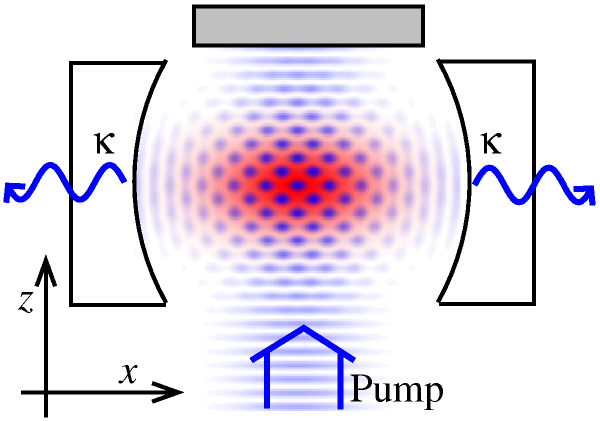
Cartoon figure of cold atoms interacting with light
in an optical cavity, as well as a perpendicular pump laser.
[Adapted from Keeling et al.
Phys. Rev. Lett. 105 043001]
For large numbers of atoms in close proximity, one can see
collective effects — behaviour that is not describable by
each atom acting independently. This idea was first discussed
by Dicke, who considered the rate of emission of radiation of
initially excited atoms, when radiating into free space. When
large numbers of atoms are instead placed in a cavity, the
simplest model of interaction between atoms and light would
suggest they can have an even more dramatic effect; i.e. above a
certain density, the atoms would spontaneously polarise and
start generating a self-consistent electric field to maintain
their polarisation.
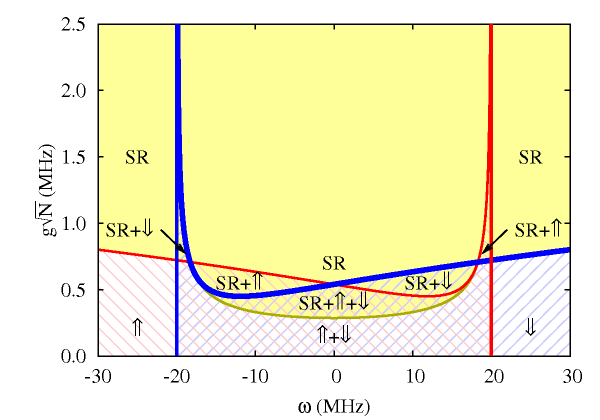
Phase diagram as a function of effective pump detuning
(horizontal) and pump strength (vertical)
[Adapted from Keeling et al.
Phys. Rev. Lett. 105 043001]
For real atoms in an optical cavity, this idea does not work,
as the limitations of the model become relevant under the same
conditions where the transition might be expected. However, the
transition can be made to happen in other systems, where the
model as originally conceived can in fact be applied. One
instance of this concerns cold atoms in an optical cavity,
pumped by a perpendicular laser beam [See Baumann et al. Nature 464, 1301
(2010)], as illustrated to the left. In this case, the
transition corresponds to a jump in the intensity of light in
the cavity mode, as one varies the strength and frequency of the
pumping laser.
While the basic idea of the transition in this system can be
reduced to a well studied model, differences between the actual
system and the idealised model can in this case lead to novel
polarised states, including regions where multiple phases exist
simultaneously. These systems potentially allow one to explore
the collective dynamics of a non-equilibrium quantum system, and
thus gain insight into the range of states such pumped systems
can display.
Recent articles on the Dicke model
- Sign-Changing Photon-Mediated Atom Interactions in Multimode Cavity Quantum Electrodynamics
Y. Guo, R. M. Kroeze, V. D. Vaidya, J. Keeling, and B. L. Lev
Phys. Rev. Lett.
122 193601 (2019)
(DOI: 10.1103/PhysRevLett.122.193601)
- Emergent and broken symmetries of atomic self-organization arising from Gouy phase shifts in multimode cavity QED
Y. Guo, V. D. Vaidya, R. M. Kroeze, R. A. Lunney, B. L. Lev, and J. Keeling
Phys. Rev. A
99 53818 (2019)
(DOI: 10.1103/PhysRevA.99.053818)
- Atom-only descriptions of the driven-dissipative Dicke model
F. Damanet, A. J. A. Daley, and J. Keeling
Phys. Rev. A
99 033845 (2019)
(DOI: 10.1103/PhysRevA.99.033845)
- Spinor Self-Ordering of a Quantum Gas in a Cavity
R. M. Kroeze, Y. Guo, V. D. Vaidya, J. Keeling, and B. L. Lev
Phys. Rev. Lett.
121 163601 (2018)
(DOI: 10.1103/PhysRevLett.121.163601)
- Generalized classes of continuous symmetries in two-mode Dicke models
R. I. Moodie, K. E. Ballantine, and J. Keeling
Phys. Rev. A
97 033802 (2018)
(DOI: 10.1103/PhysRevA.97.033802)
- Tunable-Range, Photon-Mediated Atomic Interactions in Multimode Cavity QED
V. D. Vaidya, Y. Guo, R. M. Kroeze, K. E. Ballantine, A. J. Kollár, J. Keeling, and B. L. Lev
Phys. Rev. X
8 011002 (2018)
(DOI: 10.1103/PhysRevX.8.011002)
- Superradiant and lasing states in driven-dissipative Dicke models
P. Kirton and J. Keeling
New J. Phys.
20 015009 (2018)
(DOI: 10.1088/1367-2630/aaa11d)
- Suppressing and restoring the dicke superradiance transition by dephasing and decay
P. Kirton and J. Keeling
Phys. Rev. Lett.
118 123602 (2017)
(DOI: 10.1103/PhysRevLett.118.123602)
- Dynamics of nonequilibrium Dicke models
M. J. Bhaseen, J. Mayoh, B. D. Simons, and J. Keeling
Phys. Rev. A
85 013817 (2012)
(DOI: 10.1103/PhysRevA.85.013817)
- Collective dynamics of bose-einstein condensates in optical cavities
J. Keeling, M. J. Bhaseen, and B. D. Simons
Phys. Rev. Lett.
105 43001 (2010)
(DOI: 10.1103/PhysRevLett.105.043001)
Creating controlled electron pulses in 1D wires

Schematic diagram of density of electrons, holes, and total
charge within a pulse, after application of a time-dependent
voltage
When a voltage is applied to a conducting wire, a current
results. However, in most cases, far more electrons are excited
than are necessary to create this current. Instead, excited
electron hole pairs are also created, and so the description of
the state of the wire following an arbitrary voltage is quite
complicated.
However, it turns out that there are ways in which one can
insert a single electron into a wire without the creation of
additional electron hole paris. This can for example be done by
applying a lorenzian voltage pulse, or by coupling the wire to a
quantum dot storing a single electron, and then varying the
energy of the dot with the correct time dependence. In both
these cases, quantum mechanical interference can cause a
cancellation that prevents excitations being created.
This system again allows one to explore non-equilibrium quantum
dynamics in a driven system, but one involving electrons, rather
than photons, and consequently showing a quite different variety
of behaviour.

